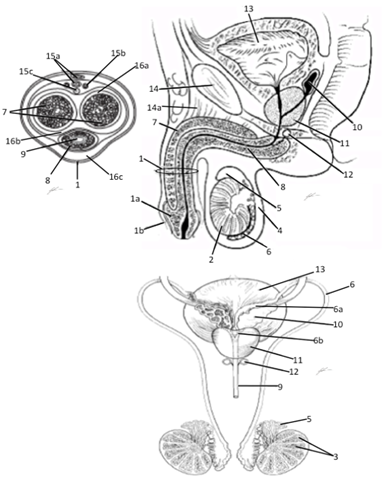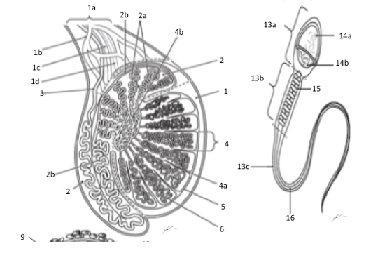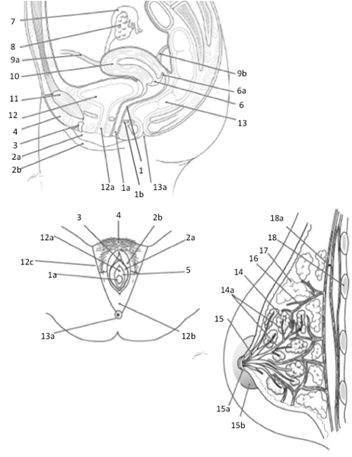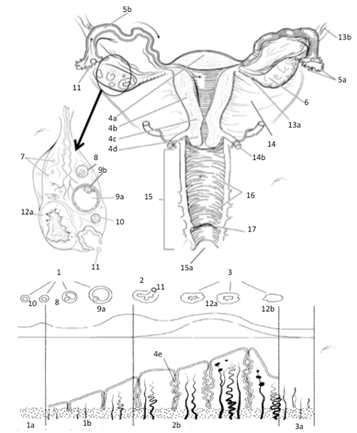1.19: Reproductive System
- Page ID
- 59165
\( \newcommand{\vecs}[1]{\overset { \scriptstyle \rightharpoonup} {\mathbf{#1}} } \)
\( \newcommand{\vecd}[1]{\overset{-\!-\!\rightharpoonup}{\vphantom{a}\smash {#1}}} \)
\( \newcommand{\dsum}{\displaystyle\sum\limits} \)
\( \newcommand{\dint}{\displaystyle\int\limits} \)
\( \newcommand{\dlim}{\displaystyle\lim\limits} \)
\( \newcommand{\id}{\mathrm{id}}\) \( \newcommand{\Span}{\mathrm{span}}\)
( \newcommand{\kernel}{\mathrm{null}\,}\) \( \newcommand{\range}{\mathrm{range}\,}\)
\( \newcommand{\RealPart}{\mathrm{Re}}\) \( \newcommand{\ImaginaryPart}{\mathrm{Im}}\)
\( \newcommand{\Argument}{\mathrm{Arg}}\) \( \newcommand{\norm}[1]{\| #1 \|}\)
\( \newcommand{\inner}[2]{\langle #1, #2 \rangle}\)
\( \newcommand{\Span}{\mathrm{span}}\)
\( \newcommand{\id}{\mathrm{id}}\)
\( \newcommand{\Span}{\mathrm{span}}\)
\( \newcommand{\kernel}{\mathrm{null}\,}\)
\( \newcommand{\range}{\mathrm{range}\,}\)
\( \newcommand{\RealPart}{\mathrm{Re}}\)
\( \newcommand{\ImaginaryPart}{\mathrm{Im}}\)
\( \newcommand{\Argument}{\mathrm{Arg}}\)
\( \newcommand{\norm}[1]{\| #1 \|}\)
\( \newcommand{\inner}[2]{\langle #1, #2 \rangle}\)
\( \newcommand{\Span}{\mathrm{span}}\) \( \newcommand{\AA}{\unicode[.8,0]{x212B}}\)
\( \newcommand{\vectorA}[1]{\vec{#1}} % arrow\)
\( \newcommand{\vectorAt}[1]{\vec{\text{#1}}} % arrow\)
\( \newcommand{\vectorB}[1]{\overset { \scriptstyle \rightharpoonup} {\mathbf{#1}} } \)
\( \newcommand{\vectorC}[1]{\textbf{#1}} \)
\( \newcommand{\vectorD}[1]{\overrightarrow{#1}} \)
\( \newcommand{\vectorDt}[1]{\overrightarrow{\text{#1}}} \)
\( \newcommand{\vectE}[1]{\overset{-\!-\!\rightharpoonup}{\vphantom{a}\smash{\mathbf {#1}}}} \)
\( \newcommand{\vecs}[1]{\overset { \scriptstyle \rightharpoonup} {\mathbf{#1}} } \)
\( \newcommand{\vecd}[1]{\overset{-\!-\!\rightharpoonup}{\vphantom{a}\smash {#1}}} \)
\(\newcommand{\avec}{\mathbf a}\) \(\newcommand{\bvec}{\mathbf b}\) \(\newcommand{\cvec}{\mathbf c}\) \(\newcommand{\dvec}{\mathbf d}\) \(\newcommand{\dtil}{\widetilde{\mathbf d}}\) \(\newcommand{\evec}{\mathbf e}\) \(\newcommand{\fvec}{\mathbf f}\) \(\newcommand{\nvec}{\mathbf n}\) \(\newcommand{\pvec}{\mathbf p}\) \(\newcommand{\qvec}{\mathbf q}\) \(\newcommand{\svec}{\mathbf s}\) \(\newcommand{\tvec}{\mathbf t}\) \(\newcommand{\uvec}{\mathbf u}\) \(\newcommand{\vvec}{\mathbf v}\) \(\newcommand{\wvec}{\mathbf w}\) \(\newcommand{\xvec}{\mathbf x}\) \(\newcommand{\yvec}{\mathbf y}\) \(\newcommand{\zvec}{\mathbf z}\) \(\newcommand{\rvec}{\mathbf r}\) \(\newcommand{\mvec}{\mathbf m}\) \(\newcommand{\zerovec}{\mathbf 0}\) \(\newcommand{\onevec}{\mathbf 1}\) \(\newcommand{\real}{\mathbb R}\) \(\newcommand{\twovec}[2]{\left[\begin{array}{r}#1 \\ #2 \end{array}\right]}\) \(\newcommand{\ctwovec}[2]{\left[\begin{array}{c}#1 \\ #2 \end{array}\right]}\) \(\newcommand{\threevec}[3]{\left[\begin{array}{r}#1 \\ #2 \\ #3 \end{array}\right]}\) \(\newcommand{\cthreevec}[3]{\left[\begin{array}{c}#1 \\ #2 \\ #3 \end{array}\right]}\) \(\newcommand{\fourvec}[4]{\left[\begin{array}{r}#1 \\ #2 \\ #3 \\ #4 \end{array}\right]}\) \(\newcommand{\cfourvec}[4]{\left[\begin{array}{c}#1 \\ #2 \\ #3 \\ #4 \end{array}\right]}\) \(\newcommand{\fivevec}[5]{\left[\begin{array}{r}#1 \\ #2 \\ #3 \\ #4 \\ #5 \\ \end{array}\right]}\) \(\newcommand{\cfivevec}[5]{\left[\begin{array}{c}#1 \\ #2 \\ #3 \\ #4 \\ #5 \\ \end{array}\right]}\) \(\newcommand{\mattwo}[4]{\left[\begin{array}{rr}#1 \amp #2 \\ #3 \amp #4 \\ \end{array}\right]}\) \(\newcommand{\laspan}[1]{\text{Span}\{#1\}}\) \(\newcommand{\bcal}{\cal B}\) \(\newcommand{\ccal}{\cal C}\) \(\newcommand{\scal}{\cal S}\) \(\newcommand{\wcal}{\cal W}\) \(\newcommand{\ecal}{\cal E}\) \(\newcommand{\coords}[2]{\left\{#1\right\}_{#2}}\) \(\newcommand{\gray}[1]{\color{gray}{#1}}\) \(\newcommand{\lgray}[1]{\color{lightgray}{#1}}\) \(\newcommand{\rank}{\operatorname{rank}}\) \(\newcommand{\row}{\text{Row}}\) \(\newcommand{\col}{\text{Col}}\) \(\renewcommand{\row}{\text{Row}}\) \(\newcommand{\nul}{\text{Nul}}\) \(\newcommand{\var}{\text{Var}}\) \(\newcommand{\corr}{\text{corr}}\) \(\newcommand{\len}[1]{\left|#1\right|}\) \(\newcommand{\bbar}{\overline{\bvec}}\) \(\newcommand{\bhat}{\widehat{\bvec}}\) \(\newcommand{\bperp}{\bvec^\perp}\) \(\newcommand{\xhat}{\widehat{\xvec}}\) \(\newcommand{\vhat}{\widehat{\vvec}}\) \(\newcommand{\uhat}{\widehat{\uvec}}\) \(\newcommand{\what}{\widehat{\wvec}}\) \(\newcommand{\Sighat}{\widehat{\Sigma}}\) \(\newcommand{\lt}{<}\) \(\newcommand{\gt}{>}\) \(\newcommand{\amp}{&}\) \(\definecolor{fillinmathshade}{gray}{0.9}\)Objectives:
At the end of this lab, you will be able to…
1. Correctly use anatomical terminology to identify the organs and tissues associated with the male reproductive system
2. Correctly use anatomical terminology to identify the organs and tissues associated with the female reproductive system
3. Determine the role of the tissue and organs of the reproductive system for overall regulation of homeostasis
Pre-Lab Exercises:
After reading through the lab activities prior to lab, complete the following before you start your lab.
1. The organs of the male reproductive system include: .
2. The organs of the female reproductive system include: .
3. The reproductive system will begin to differentiate at weeks of fetal development when a spike in the hormone occurs.
4. Color the images for use as a reference for identifying the organs.
Materials:
- Torso Model
- Reproductive Models
- Stickers
- Felt Pens
- Colored Pencils
- Traits Tables
- Coins
The reproductive system is a dimorphic system that is “gender specific” and has differential functions for each gender. System begins to develop around week 5-6 as prototypical gonads and then when a spike of Testosterone occurs, male gonads begin to develop, and differential morphology is seen at 10 weeks. While, within the developing female the initial cell division of the gametes are taking place leading to the development of primordial follicles.
Functionality of system doesn’t occur until puberty when a spike in testosterone leads to male development and estrogen/progesterone leads to female development. For the female, the development and acquisition of ornamental (subcutaneous) fat deposits are needed for developing a functional reproductive system that also is associated with musculoskeletal adjustments within pelvic bowel necessary for gestation and birthing. While both morphologies have the primarily responsibility for the generation of gametes and structures that allow for the fusion of gametes for the production of viable offspring, each provides different stimulus for morphology changes throughout the lifespan of the individual.
The principal organs of the female reproductive system are the uterus, ovaries, external genitals, and mammary glands. System provides the organs and secretions that provide protection and support during gestation (the growth, development and maturation) of the offspring. the principal organs of the male reproductive system are the testes, penis, and prostate gland. Where regardless of the individual all hypothalamic regulation is based on estradiol feedback on gonadotropic cells of the hypothalamus, with for males some involvement with testosterone as well. These gonadotropic cells are principally found in the Anterior, Lateral, Paraventricular, Pre-optic, Ventromedial Nuclei and Mammary Body of the hypothalamus. These same nuclei are also sensitive to thermoreceptors, which is one of the rationales for “hot flash” issues females have during the menopause sequence or during hormone replacement therapy. All of which also have involvement with psychological and somatic responses and modulation of oxytocin and prolactin production & release from pituitary along with a regulation and modulation from Agouti-Related Protein, NPY and Leptin via the regulated release of Kisspeptin that modulates GnRH release.
Reproduction will lead to fertilization and then gestation of the fetus. Gestation is the period of offspring development that includes the stages of (fertilization and formation of zygote, embryogenesis and neurulation, morphogenesis and maturation of the fetus and birthing) during which the offspring not only grows (from single cell to billions and billions of cells) but also elaborates and undergoes cell specialization in both structure and function in the offspring.
Additionally, reproduction deals with the ideas of genetics and inheritance of traits from parents by the offspring child that is best described by reviewing the mendelian laws of genetic inheritance and issues of genetic modifications that influence the development of the offspring both during gametogenesis and following fertilization (during the period of gestation). Beyond these laws of inheritance, there are issues during development that can influence the morphological development of the offspring that are known as teratogens. Lastly, over the last decades we have built a better understanding regarding the issues of what a female (and male) can, or cannot, do that influence the development of functional gametes, fetal development and health of the offspring following gestation.
Activity 1: Male Reproductive Anatomy
|
Male Reproductive Anatomy 1 Penis 1a Glans Penis 1b Head of Penis 2 Testicle 3 Seminiferous Tubule 4 Scrotum 5 Epididymis 6 vas Defrens (Ductus Defrens) 6a Ampulla of Seminal Vesicles 6b Ejaculatory Duct 7 Corpus Cavernosum 8 Corpus Spongiosum 9 Urethra 10 Seminal Vesicles 11 Prostate Gland 12 Cowper’s (Bulbourethral) Gland 13 Urinary Bladder 14 Pubic Bone 14a Suspensory Ligament 15a Dorsal Penile Vein 15b Dorsal Penile Artery 15c Penile Nerve 16a Tunica Albuginea 16b Buck’s Fascia 16c Areolar Tissue Color each structure or organ a different color to assist with identification |
|
Testicular and Sperm Anatomy 1a Spermatocord 1b Gonadal Vein 1c Gonadal Artery 1d Nerve to Testicle 2 Epididymis 2a Efferent Duct 2b Epididymal Duct 3 vas Defrens (Ductus Defrens) 4 Lobule of Testis 4a Septum of Lobule 4b Rete Testis 5 Capsule 6 Seminiferous Tubule 13a Head of Sperm 13b Midpiece of Sperm 13c Tail of Sperm 14a Acrosomes 14b Haploid Nucleus 15 Mitochondria 16 Flagellum Color each structure or organ a different color to assist with identification |
1. Obtain torso and reproductive models, stickers and felt pen.
2. Write the organs and structures that you should be able to identify on the stickers
Testicle, Epididymis, Spermatocord, vas Defrens (Ductus Defrens), Scrotum, Prostate Gland, Seminal Vesicles, Penis, Glans Penis, Corpus Cavernosum, Corpus Spongiosum
3. Take turns within your group to label the structures. As you label indicate the function of the organ or structure for the excretory system
|
Organ/Structure |
Function |
|
Testicle |
|
|
Vas Defrens (Ductus Defrens) |
|
|
Scrotum |
|
|
Prostate Gland |
|
|
Seminal Vesicles |
|
|
Corpus Cavernosum |
4. Have your instructor check your labeling before moving to Activity 2.
Activity 2: Female Reproductive Anatomy
1. Obtain torso and reproductive models, stickers and felt pen.
2. Write the organs and structures that you should be able to identify on the stickers
Ovary, Fallopian (Uterine) Tube, Uterus, Cervix, Vagina, Mammary Gland, Lactiferous Sinus, Nipple, Areola (and glands)
|
Female Reproductive Anatomy 1 Vagina 1a Vaginal Orifice 1b Skene’s Gland 2a Labia Minora 2b Labia Majora 3 Clitoris 4 Mons Pubis 5 Vestibule 6 Cervix 6a Fornix 7 Fimbriae & Fallopian Tube 8 Ovary 9a Round Ligament 9b Uterosacral Ligament 10 Uterus 11 Pubic Bone 12 Urinary Bladder 12a Urethra 12b Anal Triangle 12c Urogenital Triangle 13 Colon 13a Anus 14 Mammary Gland (Lobes) 14a Lobular Duct 15 Lactiferous Sinus 15a Nipple 15b Areola. 16 Blood Vessel 17 Adipose Tissue 18 Costal 18a Pectoralis Major Color each structure or organ a different color to assist with identification |
|
Ovarian and Uterine Anatomy 1 Follicular Phase 1a Menstruation of Endometrium 1b Endometrial Proliferation Phase 2 Ovulation 2b Endometrial Secretory Phase 3 Luteal Phase 3a Endometrial Sloughing Phase 4a Fundus of Uterus 4b Body of Uterus 4c Isthmus of Uterus 4d Cervix of Uterus 4e Endometrial Gland 5a Fimbriae 5b Fallopian/Uterine Tube 6 Ovary 7 Primordial Follicle 8 Primary Follicle 9a Mature Follicle 9b Secondary Oocyte 10 Primary Follicle 11 Ovulate 12a Corpus Luteum 12b Corpus Albicans 13a Ovarian Ligament 13b Ovarian Suspensory Ligament 14 Broad Ligament 14b Uterosacral Ligament 15 Vagina 15a Vaginal Orifice 16 Rugae of Vagina Color each structure or organ a different color to assist with identification |
3. Take turns within your group to label the structures. As you label indicate the function of the organ or structure for the excretory system
|
Organ/Structure |
Function |
|
Ovary |
|
|
Fallopian (Uterine) Tubes |
|
|
Uterus |
|
|
Vagina |
|
|
Mammary Gland |
|
|
Nipple and Areola |
4. Have your instructor check your labeling before cleaning up your area.
Activity 3: Heredity and Reproduction
The formation of gametes occurs via the process of meiosis, where at the end of the process cells that are formed will contain ½ the allotment of chromosomes as the original cells in the process. So that when they interact and form the zygote, the cell will have the correct allotment of chromosomes. The key steps during the formation of gametes lead to variability of the genes (and physical characteristics) seen in offspring, relative to parents.
The stages of gametogenesis that lead to this genetic diversity are based on Mendel’s laws of inheritance. The two that are very important remember are the laws of independent assortment and the segregation of the alleles (genes). Which indicates that genes can be “assigned” independent of all other genes to any of the gametes and can be exchanged between chromosomes independent of any other gene on the chromosome during both the formation of the gametes. Not only will the genes be “assigned” independently during the process of forming the gamete, but they can also assemble in the zygote independently, too. We can examine the likelihood of genes being passed from the parent to the offspring through the development of the Punnett Square.
The Punnett Square is the process by which we indicate the various possible genes that each parent can contribute for given physical traits and then the possible combinations that each possible contribution can be seen in the offspring. All these chances of how genes separate and then coalesce in the zygote gives us distinct probability charts that we can use for predicting what the child might express. In examining these probabilities there are two things that we always must remember. First, the chance of getting any single gene from a parent is random (a flip of the coin). Second, the chance of having the gene being expressed is based on the concept of dominance. Where the child has equal chance of getting any copy of any gene that the parent has but will express those genes based the resulting combination of genes from both parents. In which, dominant traits will always have some degree of being expressed (depending on being fully dominant or having a co-dominance or an incomplete dominance expression) while the recessive traits are only expressed when the person has two identical recessive genes (homozygous recessive).
To examine this concept, we will be exploring the genetic inheritance and probability of expressing traits for one’s facial features.
1. Determine the genotype for your facial features
|
Characteristic |
Dominant (Phenotype) |
Heterozygote (Phenotype) |
Recessive (Phenotype) |
|
Mouth |
QQ (Wide) |
Qq (Average) |
qq (Narrow) |
|
Lip (Thickness) |
JJ (Thick) |
Jj (Thick) |
jj (Thin) |
|
Dimples |
KK (Present) |
Kk (Present) |
kk (absent) |
|
Face (Freckles on Cheeks) |
($)($) (Present) |
($)$ (Present) |
$$ (Absent) |
|
Face (Freckles on Forehead) |
(A)(A) (Present) |
(A)@ (Present) |
@@(Absent) |
|
Face (Shape) |
RR (Round) |
Rr (Oval) |
rr (Sqaure) |
|
Face (Chin-Prominence) |
LL (Prominent) |
Ll (Less Prominent) |
ll (not Prominent) |
|
Face (Chin-Shape) —Linked with Prominent Chin |
SS (Round) |
Ss (Oval) |
ss (Sqaure) |
|
Face (Chin-Cleft) –Linked with Prominent Chin |
CC (Cleft Present) |
Cc (Small Cleft Present) |
cc (Absent Cleft) |
|
Nose (Shape) |
UU (Rounded) |
Uu (Rounded) |
uu (Pointed) |
|
Nose (Size) |
NN (Big) |
Nn (Medium) |
nn (Small) |
|
Ears (Lobe Attached) |
ZZ (Free) |
Zz (Free) |
zz (Attached) |
|
Ears (Hairy) |
DD (Present) |
Dd (Present) |
dd (Absent) |
|
Eyes (Color)— Polygenic |
FFBB (Dark Brown) |
FFBb (Brown) |
ffbb (Pale Blue) |
|
FFbb (Brown) |
|||
|
FfBB (Brown) |
|||
|
FfBb (Dark Blue) |
|||
|
Ffbb (Dark Blue toward Green) |
|||
|
ffBB (Light Blue or Gray) |
|||
|
ffBb (Light Blue toward Gray-Green) |
|||
|
Eyes (Size) |
II (Large) |
Ii (Medium) |
ii (Small) |
|
Eyes (Shape) |
VV (Almond) |
Vv (Almond) |
vv (Round) |
|
Eyes (Distance between) |
OO (Close) |
Oo (Less Close) |
oo (Far Away) |
|
Eyes (Eyebrow Thickness) |
TT (Thick) |
Tt (Thick) |
tt (Thin) |
|
Eyes (Eyebrow Placement) |
EE (Far Apart) |
Ee (Near but not touching) |
ee (Touching @ midline) |
|
Eyelash (Length) |
MM (Long) |
Mm (Long) |
mm (Short) |
|
Eyes (Lash Style) |
MM (Prominent & Robust) |
Mm (Prominent & Thin) |
mm (Non-Prominent &Thin) |
|
Hair (Style/Type) |
WW (Curly) |
Ww (Wavy) |
ww (Straight) |
|
Hair (Widow’s Peak) |
PP (Present) |
Pp (Present-less pronounce) |
pp (Absent) |
|
Hair (Color)— Polygenic |
HHHH/HHHH (Black) |
HHHH/HHHh (Dark Brown) |
HHHH/hhhh (Blond) |
|
HHHH/HHhh (Dark Brown) |
hhhh/hhhh (Platinum Blond) |
||
|
HHHh/HhHh (Brown) |
|||
|
HhHh/Hhhh (Light Brown) |
|||
|
Hhhh/Hhhh (Dark Blond) |
|||
|
Hair (Red Color Presence) |
GG (Red Present) |
Gg (Blended Red) |
gg (Absent) |
|
Skin (Color)— Polygenic |
AAA/AAA (Very Dark Brown or Black) |
AAA/AAa (Very Dark Brown, not Black) |
aaa/aaa (Very Light Tan or Pale) |
|
AAA/Aaa (Dark Brown) |
|||
|
AAA/aaa (Medium Brown |
|||
|
AAa/aaa (Light Brown) |
|||
|
Aaa/aaa (Light Tan, not Pale) |
2. Create a table of phenotypes and genotypes that are possible for each parent in your pairing.
a. Use yourself as 1 parent and your lab partner as the other parent.
|
TRAIT |
Father’s Genotype |
Mother’s Genotype |
Child’s Genotype |
Child’s Phenotype |
|
SEX/GENDER |
Father flips a coin to determine child’s gender |
|||
|
XY |
XX |
X |
||
|
Mouth |
||||
|
Lip (Thickness) |
||||
|
Dimples |
||||
|
Face (Freckles on Cheeks) |
||||
|
Face (Freckles on Forehead) |
||||
|
Face (Shape) |
||||
|
Face (Chin-Prominence) |
||||
|
Face (Chin-Shape) —Linked with Prominent Chin |
||||
|
Face (Chin-Cleft) –Linked with Prominent Chin |
||||
|
Nose (Shape) |
||||
|
Nose (Size) |
||||
|
Ears (Lobe Attached) |
||||
|
Ears (Hairy) |
||||
|
Eyes (Color) |
||||
|
Eyes (Size) |
||||
|
Eyes (Shape) |
||||
|
Eyes (Distance between) |
||||
|
Eyes (Eyebrow Thickness) |
||||
|
Eyes (Eyebrow Placement) |
||||
|
Eyelash |
||||
|
Eyes (Lash Style) |
||||
|
Hair (Style/Type) |
||||
|
Hair (Widow’s Peak) |
||||
|
Hair (Color)-- Polygenic |
||||
|
Hair (Red Color Presence) |
||||
|
Skin (Color)-- Polygenic |
||||
3. Determine the Genotype for the child:
a. To determine the gender of the child, have the father will flip the coin
i. HEADS=Girl, TAILS=Boy
Think about Question: WHY THE MALE IS THE ONLY PARENT TO FLIP A COIN TO DETERMINE THE SEX OF THE CHILD.
Think about question: EXPLAIN WHAT THE COIN REPRESENTS
b. If the parent is heterozygous for a trait, then that person will have to flip a coin to determine which allele is passed to the child.
i. Designate HEADS=Dominant and TAILS=Recessive
ii. If both parents are heterozygous, each will flip the coin (simultaneously) for each of the trait that is heterozygous on the chart.
1. Results of the allele assortment is as follows:
a. Two tails indicate homozygous recessive trait expressed.
b. One head and One tail indicate heterozygous trait expressed
c. Two heads indicate homozygous dominant trait expressed.
d. For Polygenic traits flip the coin each time for the individual genes within the polygenetic trait.
c. If the parent is homozygous then simply write the only allele that can be passed to the child in the designated area
d. Record the outcome of genotype for the child based on the results of the coin flips
4. Record the phenotype that the child
a. Based on results of the combination of alleles, compare the child’s genotype with the indicate characteristic for facial features
b. Write the phenotype that is expressed based on the results of the genotype combination.
5. To the best of your ability, draw a representation of the outcome of all flips to create a drawing of the child that results from the two parents in this lab.





